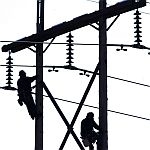 (Host) Operators of the state’s electric transmission grid say Vermont is well positioned to take advantage of massive energy projects beyond its borders.
(Host) Operators of the state’s electric transmission grid say Vermont is well positioned to take advantage of massive energy projects beyond its borders.
But the Vermont Electric Power Company says new transmission lines may be needed to handle some of the increased demand.
VPR’s John Dillon has more:
(Dillon) Vermont sits between major energy suppliers – such as Hydro-Quebec – and cities in the Northeast, which have a growing demand for power.
Kerrick Johnson is vice president with the Vermont Electric Power Company, or VELCO, which manages the state’s transmission grid.
(Johnson) "Essentially there is system bottlenecks to the south and east of us, which makes Vermont‘s transmission system particularly valuable."
(Dillon) Johnson ticked off the potential projects which could send electricity over Vermont’s power line network.
(Johnson) "You have wind power in upper New York State that is constrained – it’s essentially trapped, they can’t get the energy out. You have more projects being built, wind and hydro projects, being built in Canada. You have wind projects to our east being proposed in Maine and parts of New Hampshire. But the power that’s generated needs to move to where the markets are."
(Dillon) Think of all those thousands of new megawatts as cars on a busy highway. Vermont’s transmission network could serve as a toll road, with VELCO running the toll booth.
(Johnson) "They’ll pay for transmission service, and the utility pays for power that’s being generated."
(Dillon) It’s uncertain whether these projects would reduce rates for consumers.
VELCO has beefed up its transmission lines and substations over the past few years. The projects were designed to improve the reliability of the system. But some of the work has also improved the capacity of the network to carry new power loads.
Yet even more power lines could be needed if the state becomes a major conduit for electricity to the population centers of the Northeast. Johnson says the state’s location – and the energy projects being developed outside its borders – will give utilities more choice.
(Johnson) "New power lines may be a part of that solution. But I think most people would agree it’s better to have more options than to be limited to one or two choices for our power."
(Dillon) But power lines often carry an environmental and economic cost. Sandra Levine is with the Conservation Law Foundation. She points out that new power lines from the Midwest to New England could carry power from coal plants, as well as from wind generators.
(Levine) "We’ve also seen that with our growing reliance on energy efficiency in Vermont, that we simply don’t need to be importing more power. And there’s a serious concern that these lines will be used simply to import more expensive power and more polluting power from the Midwest. Transmission lines are very expensive. They’re very expensive to build, and a large portion of the increased electric rates that Vermonters are seeing now are a result of these transmission projects."
(Dillon) VELCO hasn’t announced what new lines are needed. But the company says that any projects it puts forward will have tangible benefits for the state.
For VPR News, I’m John Dillon in Montpelier.